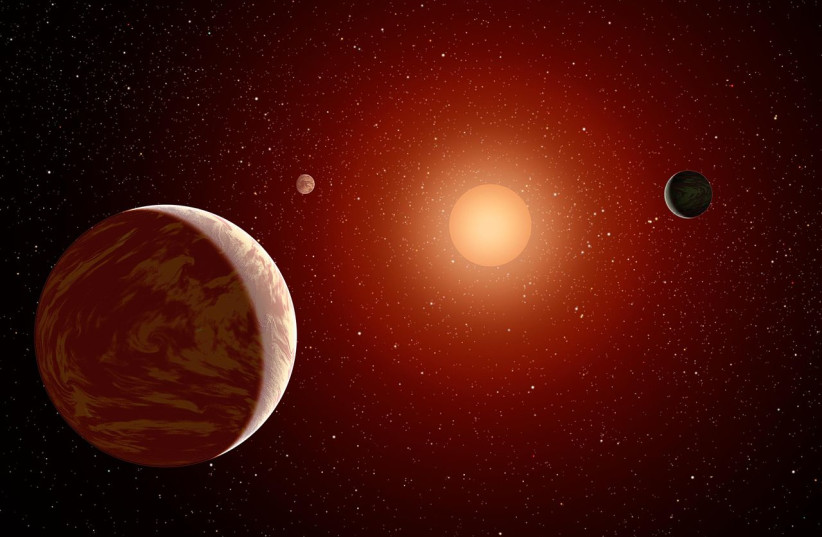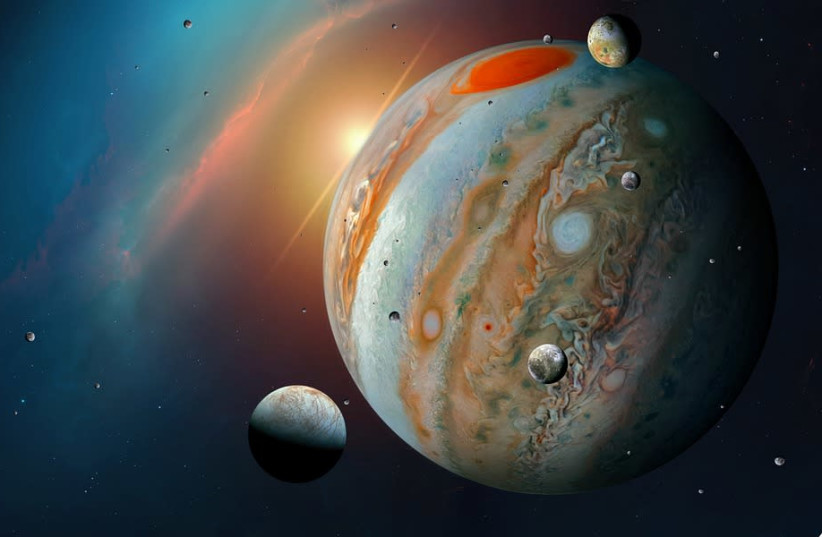Direct imaging unveils 'Jupiter's younger sibling': Landmark in exoplanet exploration
This method could revolutionize the way we discover extrasolar planets, especially those that are challenging to detect due to their distance, mass, or orientation relative to Earth.
Scientists at the University of Texas at Austin have successfully employed astrometry to directly capture images of AF Lep b, one of the lowest-mass planets ever observed.
This method could revolutionize the way we discover extrasolar planets, especially those that are challenging to detect due to their distance, mass, or orientation relative to Earth. The peer-reviewed study, led by astronomy graduate student Kyle Franson, is published in the Astrophysical Journal Letters.
Astronomers, using data from the W. M. Keck Observatory on Maunakea, Hawaii, have discovered one of the lowest-mass planets whose images have been directly captured. Not only were they able to measure its mass, but they were also able to determine that its orbit is similar to the giant planets in our own solar system.
What is this planet?
The planet, called AF Lep b, is among the first ever discovered using a technique called astrometry; this method measures the subtle movements of a host star over many years to help astronomers determine whether hard-to-see orbiting companions, including planets, are gravitationally tugging at it.

“When we processed the observations using the Keck II telescope in real time to carefully remove the glare of the star, the planet immediately popped out and became increasingly apparent the longer we observed,” said Franson.
The direct images Franson’s team captured revealed that AF Lep b is about three times the mass of Jupiter and orbits AF Leporis, a young Sun-like star about 87.5 light-years away. They took a series of deep images of the planet starting in December 2021; two other teams also captured images of the same planet since then.
“This is the first time this method has been used to find a giant planet orbiting a young analog of the Sun,” said Brendan Bowler, an assistant professor of astronomy at UT Austin and senior author on the study. “This opens the door to using this approach as a new tool for exoplanet discovery.”
Despite having a much smaller mass than its host star, an orbiting planet causes a star’s position to wobble slightly around the center of mass of the planetary system. Astrometry uses this shift in a star’s position in the sky relative to other stars to infer the existence of orbiting planets. Franson and Bowler identified the star AF Leporis as one that might harbor a planet, given the way it had moved during 25 years of observations from the Hipparcos and Gaia satellites.
To directly image the planet, the UT Austin team used Keck Observatory’s adaptive optics system, which corrects for fluctuations caused by turbulence in Earth’s atmosphere, paired with the Keck II Telescope’s Near-Infrared Camera 2 (NIRC2) Vector Vortex Coronagraph, which suppresses light from the host star so the planet could be seen more clearly. AF Lep b is about 10,000 times fainter than its host star and is located about 8 times the Earth-Sun distance.
“Imaging planets is challenging,” Franson said. “We only have about 15 examples, and we think this new ‘dynamically informed’ approach made possible by the Keck II telescope and NIRC2 adaptive optics imaging will be much more efficient compared to blind surveys which have been carried out for the past two decades.”
The two most common ways of finding extrasolar planets involve observing slight, periodic dimming of the starlight if a planet happens to regularly pass in front of the star— like a moth spiraling around a porch light — and measuring minute changes in the frequencies of starlight that result from the planet tugging the star back and forth along the direction to Earth.
Both methods tend to work best with large planets orbiting close to their host stars, and both methods are indirect: we don’t see the planet, we only see how it influences the star.
The method of combining direct imaging with astrometry could help astronomers find extrasolar planets that were hard to find before with other methods because they were too far from their host star, were too low mass, or didn’t have orbits that were edge-on as seen from Earth.
Another benefit of this technique is that it allows astronomers to directly measure a planet’s mass, which is difficult with other methods at wide orbital distances.
Bowler said the team plans to continue studying AF Lep b.
“This will be an excellent target to further characterize with the James Webb Space Telescope and the next generation of large ground-based telescopes like the Giant Magellan Telescope and the Thirty Meter Telescope,” Bowler said. “We’re already planning more sensitive follow-up efforts at longer wavelengths to study the physical properties and atmospheric chemistry of this planet.”
Scientists at the University of Texas at Austin, led by astronomy graduate student Kyle Franson, have successfully employed astrometry to directly capture images of AF Lep b, one of the lowest-mass planets ever observed. The groundbreaking technique used by the researchers could revolutionize the discovery of extrasolar planets, particularly those that are challenging to detect due to their distance, mass, or orientation relative to Earth.
Franson expressed excitement about the real-time processing of observations using the Keck II telescope. By skillfully removing the star's glare, the planet, AF Lep b, became increasingly visible as the team extended their observations.
The direct images obtained by Franson and his colleagues revealed that AF Lep b possesses a mass approximately three times that of Jupiter and orbits a young Sun-like star named AF Leporis, situated 87.5 light-years away. Notably, two other teams also captured images of the same planet subsequent to the University of Texas at Austin's discovery.
Assistant professor of astronomy at UT Austin, Brendan Bowler, emphasized the significance of the findings, stating, "This is the first time this method has been used to find a giant planet orbiting a young analog of the Sun. This opens the door to using this approach as a new tool for exoplanet discovery."
Despite its smaller mass in comparison to its host star, an orbiting planet induces a slight wobble in the star's position around the center of mass of the planetary system. Astrometry leverages this shift in a star's position relative to other stars to infer the presence of orbiting planets.
Franson and Bowler identified the star AF Leporis as a potential host for a planet, based on its observed movement over a 25-year period using data from the Hipparcos and Gaia satellites.
To directly image the planet, the UT Austin team employed Keck Observatory's adaptive optics system, which compensates for atmospheric turbulence, and the Keck II Telescope's Near-Infrared Camera 2 (NIRC2) Vector Vortex Coronagraph, which reduces the light from the host star to enhance the planet's visibility. AF Lep b is roughly 10,000 times fainter than its host star and is located at a distance approximately eight times that between Earth and the Sun.
The challenges of imaging planets
Franson acknowledged the challenges associated with imaging planets, citing only 15 known examples to date. However, the team is optimistic about the efficiency of their novel approach, which combines astrometry with direct imaging using the Keck II telescope and NIRC2 adaptive optics imaging. This technique is expected to outperform blind surveys conducted over the past two decades.
The most common methods for discovering extrasolar planets involve detecting periodic dimming of starlight caused by a planet passing in front of its host star or observing minute changes in the frequencies of starlight due to the planet's gravitational influence.
However, both these methods are indirect and primarily effective for large planets in close proximity to their host stars. The combination of direct imaging and astrometry enables astronomers to identify extrasolar planets that were previously difficult to detect because of their distance from the host star, low mass, or non-edge-on orbital orientation from Earth. Additionally, this technique allows for direct measurement of a planet's mass, a challenging task with other methods at wider orbital distances.
Bowler indicated that the team intends to further study AF Lep b, identifying it as an excellent target for characterization using the upcoming James Webb SpaceTelescope, as well as the next generation of large ground-based telescopes such as the Giant Magellan Telescope and the Thirty Meter Telescope.
The researchers plan to conduct more sensitive follow-up studies at longer wavelengths to explore the physical properties and atmospheric chemistry of AF Lep b.



No comments:
Post a Comment